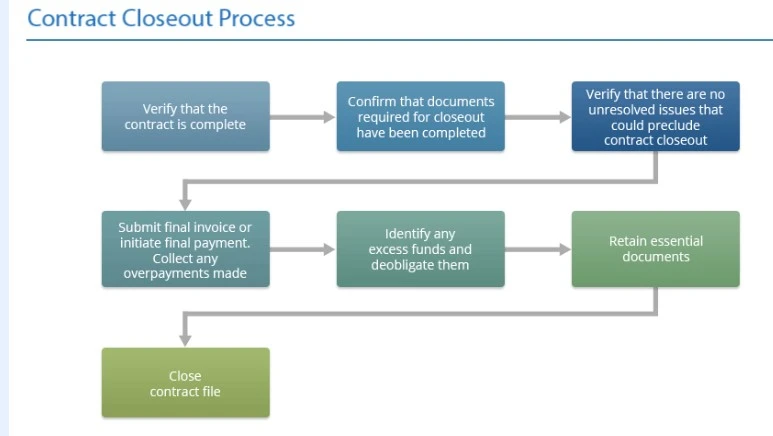Best Practices for Closing Out a Contract

Last Updated March 8, 2024
Staying on top of your company’s contracts can help maximize contract value and ensure you get what you paid for.
While most contractors follow the rules of the contract, others may not deliver the work as promised. This can be frustrating to the competition who are overlooked because contracts are awarded based on value-added promises.
If a contractor promises, for example, to hire local labor or use locally manufactured materials, that is added value you don’t want to lose. Managing your contracts and following an effective contract closeout process can help ensure contractors meet their obligations.
Consequently, real issues resulting in contract neglect include out-of-control spending once a contract is awarded and damage to supplier relationships.
As highlighted in Villanova’s Contract Management program, strategic, long-term oversight is not occurring nearly as often as it should.
Agile contract management can have an impact on this issue. It was designed to ensure projects are completed in short and demonstrable steps while working closely with clients.
The Use of Agile in Contract Management
Agile uses sprints, which are short, focused project cycles where every member of the team has responsibility to see a project through to completion. By using Agile techniques in contract management, a team focuses on establishing good working relationships between the parties of a contract.
The reason neglect may occur in contract management is because professionals at the operations level, who typically get the responsibility, are often too busy to monitor contracts.
By breaking a project down into smaller cycles, there are frequent points of inspection, which increases the likelihood for a project to stay on track and on time and ensure that everything promised is getting accomplished.
The Agile method also prioritizes creating benefits for both customers and contractors instead of the traditional winner and loser in competitive negotiations.
Looking at the Flipside
When it is time to close out a contract, the contractor has much to do, says Marge Rumbaugh, in Villanova’s Certificate in Contract Management program lectures.
This is an important step in the process to ensure that the customer gets what they paid for, she says.
Contract closeout is the process of resolving all contract issues or fulfilling contract requirements. Contract managers might need to accept supplies and contractors might need to still deliver services or meet unresolved work statement requirements. It’s essential to do this before final payment is made.
“This is not a speedy process,” Rumbaugh says in a lecture. “It can take months, especially with cost reimbursement contracts. Once you add in indirect costs, cost sharing, cost-plus-fixed-fee and so forth, the months can add up.”
There are also ethics issues and disclosure agreements which can require the individual contract to continue until three years after a final payment has been made, Rumbaugh says.
“Even though you’ve received final payment, that doesn’t mean you can shred everything,” she says. “There are document retention requirements you also need to pay attention to.”
Navigating the Contract Closeout Process

Is There a Warranty?
Even after final payment, if a contract has a warranty, it makes the contractor liable to the buyer for an extended period after the work is finished.
Also, make sure any subcontracts are completed and settled before the prime contract settlement.
If There is a Service Clause, You Must Train Your Successor
When a contract ends or you don’t win it again, don’t pack your bags and head out the door, Rumbaugh warns. This clause provides that the contractor complete phase-in training for the new contract holder.
“The services clause says that you need to train the new company. So, not only do you have the indignity of having lost the contract, but you must help the next guy come in and do the job that you just lost,” Rumbaugh explains.
Handling Classified Material
If you are working to close out a government contract that involves classified materials, there are three options:
- Retain data for follow-on contract
- Return to the government
- Destroy classified material
Government Audits
The government has broad rights to audit and shall make available at its offices, all records, materials and other evidence connected to a contract until three years after final payment.
Also included in the auditing process are the final overhead rates, determined by reviewing the contractor’s incurred direct and indirect costs.
The contractor is required to submit a final indirect cost proposal within 180 days of the close of its fiscal year.
The government must agree to those rates, or the matter can become a dispute.
Once the contract is closed out, remember to retain your records for the required time period, which could be from one year to six years and three months.
Led by expert practitioners, Villanova’s Certificate in Contract Management program teaches students how to navigate commercial and government contract management processes from contract requisition through contract closeout.





